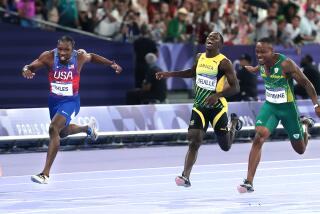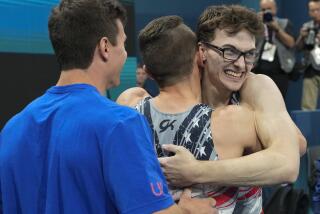O’Brien’s Decision to Wait: a Gaffe That Didn’t Ad Up
- Share via
That sound you heard coming out of the Olympic track and field trials in New Orleans over the weekend was not the crossbar hitting the ground after Dan O’Brien rapped into it twice (and went under it the third time), it was the sound of contracts ripping and money burning in the cloisters of Madison Avenue.
It was probably the costliest “no height” in track and field history. Upward of $25 million in shoe ads went up in smoke. When Dan O’Brien missed his third try at a lousy 15 feet 9 inches, about 30 PR types and a dozen account executives went back to smelling salts and the drawing boards.
A pole vault is always a cat-and-mouse game. A vaulter “passes” heights to psych out his competitors. It occasionally backfires. In 1964, the world’s best vaulter, Fred Hansen, skipped a 16-6 3/4 height and then rapped out twice at 16-8 3/4 before making it to the gold on his last try. In 1976, at Montreal, Dave Roberts passed a jump at 18-2 1/2. Then, the rains came and, in his final jump, he missed the crossbar altogether and came down on the wrong side of it. He lost the gold and had to settle for a bronze.
But that was in a regular pole vault, where only the last height counts. Dan O’Brien’s gaffe was in a decathlon, where you get points for whatever height you clear.
Dan O’Brien is not going to Barcelona because he disdained vaults at lower altitudes--14-5, 14-9, 15-1, and 15-5--where he could, so to speak, have put money in the bank and saved himself bankruptcy in the event.
Decathlon points are awarded on the basis of 1,000 points for marks most closely approximating world records in those events. O’Brien, mindful of the fact he was on a world-record pace with a first-day record total of 4,698 points, was perhaps saving his energy for a chance to score 900 points in the pole vault. After all, he had vaulted more than 17 feet in the event. Why wouldn’t he make 15-9?
Here’s why. He hit the crossbar twice and flew under it the third time.
To “no height” is a decathlete’s worst nightmare.
Was O’Brien going for the record instead of the team?
Going for the pie in the sky is not unknown in sport. Everyone remembers the 1966 U.S. Open, when Arnold Palmer, with a seven-shot lead with nine holes to play, elected to play Ben Hogan instead of Billy Casper. Both of them beat him. He was going for Hogan’s Open record but wound up three shots short of that and four shots short of Casper.
The tragedy is, Dan O’Brien could probably have chicken-scratched his way over the bar at 14-5. He might not have needed the pole. It would not have given him the record. But it wouldhave given him a ticket to Barcelona.
And it would have kept the multimillion-dollar ad campaign rolling. Reebok, one of those companies that put the world in sneakers, had bankrolled a media blitz highlighting Dan O’Brien and his fellow American decathlete, Dave Johnson, into a not-so-odd couple marketed as “The Dan and Dave Show.”
They were supposed to be the greatest pairing since The Sunshine Boys. Joined at the hip. O’Brien, in effect, broke up the act.
It is a historic gaffe on the order of Fred Merkle failing to touch second, Dempsey failing to go to a neutral corner, Palmer playing Hogan instead of Casper, Riegels running the wrong way, Lasorda pitching to Jack Clark in the ’85 playoffs, Quayle spelling potato.
Reebok rapped out. Did America? Not necessarily. We’ve still got the “Dave” show. It might not sell shoes. But it might put us back on the gold standard.
More to Read
Go beyond the scoreboard
Get the latest on L.A.'s teams in the daily Sports Report newsletter.
You may occasionally receive promotional content from the Los Angeles Times.






